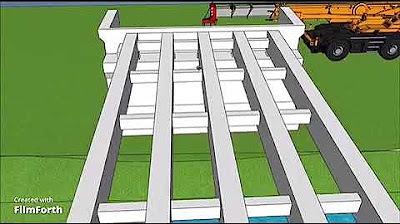Q1. How does a prestressed precast concrete bridge beam work?
Summary
TLDRThis video explains the process of pre-stressed concrete bridge beam design, focusing on pre-tensioning. It describes how pre-stressing strands are used to apply compressive forces and bending moments to a beam, improving its structural integrity. The video highlights the role of pre-tensioning, where strands are stretched and cast into concrete, which is then released to transfer the force. It also touches on the beam's cambering effect, which helps reduce deflection and ensures aesthetic stability. Additionally, shear reinforcement is mentioned, and a distinction is made between pre-tensioning and post-tensioning methods.
Takeaways
- 😀 Pre-stressing strands are used to apply compressive force to concrete beams during construction.
- 😀 The pre-stressing strands are initially slack, without tension, for safety during the setup process.
- 😀 Each pre-stressing strand can be tensioned to a load of 209 kN, exerting a large force.
- 😀 Strands are stretched using a jack to create significant tension before casting the concrete around them.
- 😀 Once the concrete reaches the required compressive strength, the tensioned strands are gradually released.
- 😀 The release of tension in the strands transfers the force into the concrete, providing compression to the beam.
- 😀 The position of the strands is eccentric to apply not only compression but also a bending moment to counteract loads during use.
- 😀 The layout of strands, with more near the bottom of the beam, helps achieve the desired bending moment and compression distribution.
- 😀 The pre-stressing process also causes the beam to naturally camber upward, which aids in deflection control and aesthetic appearance.
- 😀 The camber results from the applied bending moment and helps prevent visible sagging in the final beam structure.
- 😀 The use of shear links in the pre-stressed concrete beam is similar to those used in reinforced concrete bridge beams for shear reinforcement.
- 😀 Pre-stressed concrete bridge beams are designed to carry both flexure (bending) and shear forces.
- 😀 Concrete, being weak in tension, benefits from pre-stressing, which overcomes tensile stresses caused by bending.
- 😀 The process described pertains to pre-tensioned, pre-cast bridge beams, with a distinction between pre-tensioning and post-tensioning methods.
Q & A
What is the purpose of the pre-stressing strands in a bridge beam?
-The pre-stressing strands are used to apply a compressive force to the beam, which enhances its ability to carry loads, particularly by counteracting the bending moments caused by applied loads.
Why are the pre-stressing strands initially slack before tensioning?
-The strands are slack initially to ensure safety during handling. They are only tensioned later to avoid any premature release of force or accidents when they are still untensioned.
What is the tensile load applied to a single pre-stressing strand?
-A single pre-stressing strand is tensioned to a load of 209 kN, which is a significant amount of force necessary to create the required compression in the concrete beam.
What happens once the concrete reaches its specified compressive strength?
-Once the concrete reaches its specified compressive strength, the pre-stressing strands are gradually released, transferring the stored force in the strands into the concrete, applying compression to the beam.
How does the layout of pre-stressing strands affect the beam?
-The strands are positioned closer to the bottom of the beam to create a bending moment in addition to the compressive force. This moment helps counteract the bending moment caused by external loads applied during the beam's use.
What is cambering, and how does it benefit the beam?
-Cambering is the upward curve that the beam adopts after pre-stressing due to the moment applied during the pre-stressing operation. This is beneficial because it helps eliminate visible sagging in the beam and aids in deflection control, contributing to aesthetic and structural integrity.
What role do shear links play in pre-stressed concrete bridge beams?
-Shear links provide reinforcement against shear forces, similar to those in reinforced concrete bridge designs. They help ensure that the beam can withstand forces acting perpendicular to its length, contributing to the overall stability of the beam.
How does pre-stressed concrete differ from reinforced concrete in terms of stress management?
-In pre-stressed concrete, compression is applied to counteract the tensile stress from bending moments, while in reinforced concrete, steel bars are used to handle the tensile stresses. Pre-stressed concrete thus focuses on using compression to improve strength, while reinforced concrete uses tension reinforcement.
What is the difference between pre-tensioned and post-tensioned concrete bridge beams?
-In pre-tensioned concrete, the strands are tensioned before the concrete is poured, while in post-tensioned concrete, the strands are tensioned after the concrete has hardened. Post-tensioning allows for more flexibility in the application of force after the beam has been cast.
Why is the bottom of the beam positioned slightly above the bed during casting?
-The slight gap between the bottom of the beam and the casting bed is due to the moment applied during pre-stressing, which causes the beam to camber upward. This design helps in balancing the forces and improving the beam's performance.
Outlines

This section is available to paid users only. Please upgrade to access this part.
Upgrade NowMindmap

This section is available to paid users only. Please upgrade to access this part.
Upgrade NowKeywords

This section is available to paid users only. Please upgrade to access this part.
Upgrade NowHighlights

This section is available to paid users only. Please upgrade to access this part.
Upgrade NowTranscripts

This section is available to paid users only. Please upgrade to access this part.
Upgrade NowBrowse More Related Video

Why Pre-Stress Concrete?

Plant Tour Video

Animasi Pembuatan Jembatan Beton Bertulang Prodi Teknik Sipil F. Teknik Um Sumbar

Beton Prategang Minggu ke-2 Part 1 2021

What you must know about Post Tensioned Concrete Design

Metode Kerja Erection Girder Jembatan Prategang (Prestressed Girder) Bendungan Temef Nindya Karya
5.0 / 5 (0 votes)